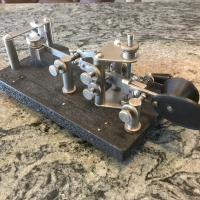SmartSDR v4.1.3 | SmartSDR v4.1.3 Release Notes
SmartSDR v3.10.15 | SmartSDR v3.10.15 Release Notes
The latest 4O3A Genius Product Software and Firmware
Need technical support from FlexRadio? It's as simple as Creating a HelpDesk ticket.
CW QSK with 6400 & Maestro
I've read countless (mostly contradictory opinion) postings about QSK in the various Flex 6000 products and it seems that at last posting, QSK was still not working quite right- at least not reliably. I'm looking at purchasing a new Flex 6400 & Maestro, but fully functional, silent QSK is a must for me. With that said, can anyone using a 6400 or 6600 with Maestro please answer the following:
1. My understanding is that Flex uses a PIN diode for the TX path in T/R switching, and a reed relay in the RX path. Can you hear the reed relay? Is it mechanically reliable?
2. It seems that QSK with the antenna tuner in-line does not work. Is this still true?
3. I've read that CW sidetone is generated locally by the Maestro, so there is no delay. If using Maestro connected via WiFi and running QSK, is there audio delay between elements due to the network latency? The same if connected via cable?
4. Is there any appreciable difference when running a 6400M vs. a 6400 with a Maestro? I don't mean to over simplify, but It appears that they 6400M is essentially a Maestro hard-wired to the front of a 6400. However, I imagine the 6400M front panel may interface differently to the 6400 so may not suffer latency introduced via ethernet. Either way, audio delay due to processing or network latency is terrible and makes QSK impossible.
I really appreciate any information that the group would be willing to share.
Thanks and 73- Jason AC7JW
Answers
-
No Maestro here but I can answer items 1 & 2. I have a 6600M. QSK works reasonably well but still needs work. It took me lots of tweaking to get it to sound good.
1. I can hear the reed relay. It is very quiet though. Flex traded silent QSK operation for better RX performance. Reed relay seems reliable so far. I am mostly CW here.
2. Yes, still true.
Joe
N3HEE0 -
I work a fair amount of CW with my 6400 and Maestro. I have no complaints about QSK or noise from the relay. I use an external Winkeyer but have used the internal keyer in the Maestro with no problems. My Maestro is connected to the 6400 with a network switch but have used WiFi but with the Maestro in the shack and the keyer connected to the 6400. I use an external tuner and mostly operate CW with headphones connected to the 6400. I don't see any issues with the 6400 as a CW rig at least from my experience.
Phil
N3ZP0 -
Thanks for the replies Joe and Phil- I really appreciate your sharing this information. The QSK issue with internal antenna tuner is a bit perplexing- I hope they come up with a fix for that!
0 -
Flex 6600 here. Not a M or Maestro.
QSK works very well and is silent using SmartSDR on computer and audio directly from 6600.
0 -
I can't get my Maestro/6400 locally attached to go into QSK and use the pin diodes. The "QSK" icon doesn't come on. Also I can't get the "delay" to go to zero. IT keeps jumping back to some number. I've read docs for both and find nothing I'm doing wrong. Using V2.6.1.72.
Will, K4IWW0 -
After once owning a 6700, I'm reluctantly considering the purchase of a 6400M, mostly for evaluation purposes. My understanding is the 6400M is equivalent to a 6400 with a remoted Maestro B. A few questions:
1) When I owned a 6700 and Maestro A, audio from the Opus CODEC was awful with far too many digital compression artifacts. Can the 6400M be operated locally without engaging the Opus CODEC?
2) The 6700 Maestro combination had a quasi-square wave CW sidetone but the 6700's local sidetone was a sinewave. Is that now corrected in the 6400M?
Paul, W9AC
0 -
1). Opus is only used on a SmartLink connection. On a local Lan the audio stream is un-compressed and uses a different codec and the audio is not compressed at all. I guess if there was a concern with digital compression artifacts today, we would hear many many users complaining. The good news is that we do not hear those complaints if they exist.
2). The sidetone on the Maestro A and B is the same. And, the same is true with the M model.
0
Leave a Comment
Categories
- All Categories
- 378 Community Topics
- 2.1K New Ideas
- 630 The Flea Market
- 8.2K Software
- 118 SmartSDR+
- 6.4K SmartSDR for Windows
- 183 SmartSDR for Maestro and M models
- 430 SmartSDR for Mac
- 271 SmartSDR for iOS
- 258 SmartSDR CAT
- 193 DAX
- 382 SmartSDR API
- 9.3K Radios and Accessories
- 38 Aurora
- 257 FLEX-8000 Signature Series
- 7.2K FLEX-6000 Signature Series
- 947 Maestro
- 56 FlexControl
- 865 FLEX Series (Legacy) Radios
- 924 Genius Products
- 463 Power Genius XL Amplifier
- 336 Tuner Genius XL
- 125 Antenna Genius
- 297 Shack Infrastructure
- 209 Networking
- 460 Remote Operation (SmartLink)
- 144 Contesting
- 787 Peripherals & Station Integration
- 139 Amateur Radio Interests
- 1K Third-Party Software


